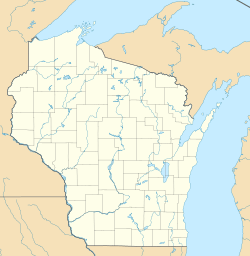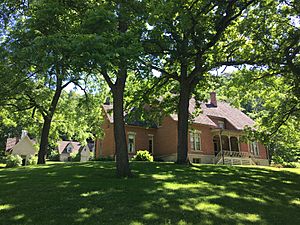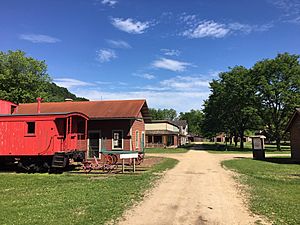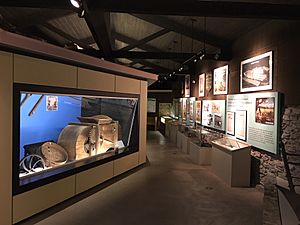Stonefield (Wisconsin) facts for kids
Quick facts for kids |
|
|
Stonefield
|
|
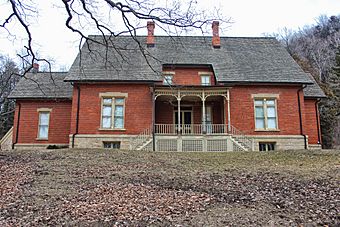 |
|
| Location | 12195 County Road VV, Cassville, Wisconsin |
|---|---|
| Area | 591 acres (239 ha) |
| Built | 1865 |
| Architectural style | Gothic |
| NRHP reference No. | 70000034 |
| Added to NRHP | May 19, 1970 |
Stonefield is a special place in Cassville, Wisconsin, United States. It was once a huge farm, about 2,000 acres, owned by Nelson Dewey. He was Wisconsin's very first governor!
Today, Stonefield is split into two parts: Nelson Dewey State Park and the Stonefield historic site. The historic site is a big museum run by the Wisconsin Historical Society. It has many cool areas for visitors to explore. You can see an old Wisconsin farmhouse, a village that looks like it did around 1900, and a rebuilt version of Nelson Dewey's home. Stonefield is also home to the Wisconsin State Agricultural Museum, which has a huge collection of old farm machines.
Stonefield, also known as the Nelson Dewey Plantation, was added to the National Register of Historic Places on May 19, 1970. This means it's a very important historical place!
Contents
Nelson Dewey: Wisconsin's First Governor
Nelson Dewey moved to Cassville from New York in 1836. He quickly got involved in politics in Wisconsin, which was a territory back then. When Wisconsin became a state in 1848, he was chosen as its first governor.
Dewey served two terms as governor. After that, he came back to Cassville. He wanted to help the village grow, so he bought land and started businesses. He also began building his own large farm, which he named "Stonefield."
The Original Stonefield Estate
The main building on his farm was a three-story brick house. It was built in the Gothic Revival style, which means it had a fancy, old-fashioned look. The house was finished in 1868.
Sadly, Dewey didn't get to enjoy his beautiful estate for long. In 1873, a fire destroyed the house. Soon after, a big money problem called the Panic of 1873 caused Dewey to lose almost everything he owned. He had to leave Stonefield and move back to Cassville village. He lived there without much money until he passed away in 1889.
Rebuilding Dewey's Home
In 1879, a man named General Walter Cass Newberry bought 40 acres of the old estate. This land included where Dewey's house used to be. Newberry farmed the land for several years. In the 1890s, he decided to rebuild Dewey's home to use as a summer house.
The new house followed the same floor plan as Dewey's original home. However, it didn't have all the fancy details of the Gothic Revival style. Newberry sold the house in 1896. It had a few different owners before the state of Wisconsin bought it. This happened when they were creating Nelson Dewey State Park.
Explore the Stonefield Historic Site
In 1953, the rebuilt Dewey house was set aside from the state park. It became a museum run by the Wisconsin Historical Society. At first, it was called the "State Farm and Crafts Museum." Later, the inside of the rebuilt Dewey home was decorated to look like Dewey's original house. Now, it helps visitors learn about Dewey's life. In 1969, the State Agricultural Museum was added to the site.
Stonefield Village: A Trip Back in Time
In 1954, the historical society started planning to add more to the Dewey house museum. They wanted to create a copy of a rural farming village and farm that would have been common in Wisconsin around 1900. Work on these projects continued into the 1970s. More buildings and old objects were added to the site.
Today, Stonefield village has over thirty buildings. These include a blacksmith shop, a general store, a schoolhouse, and other shops and community places. Some of these buildings are real historic structures that were moved to Stonefield. Others were built to look like the originals.
Near the village, the Stonefield farmhouse shows visitors what life was like for Wisconsin farm families in the early 1900s. Many of the buildings in the village and farm are staffed by people in old-fashioned costumes. They help guide visitors and explain things about the past.
Wisconsin State Agricultural Museum
The State Agricultural Museum was added to the Stonefield historic site in 1969. This museum was built to hold a large collection of old farm machines. The historical society gathered these machines while creating the Stonefield village and farm.
Inside the museum, you can see exhibits about the history of Wisconsin farming. It covers everything from when Native Americans farmed the land to the early 1900s. The museum also tells about Wisconsin's main farm equipment makers, the Case Corporation and Allis-Chalmers. It has many rare and valuable pieces of old farm equipment.
Images for kids


